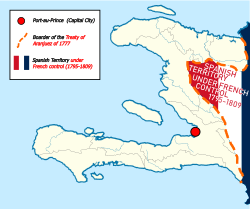
Back إمبراطورية هايتي الأولى Arabic بیرینجی هاییتی ایمپراتورلوغو AZB Primer Imperi d'Haití Catalan První Haitské císařství Czech Kaiserreich Haiti (1804–1806) German Unua Imperio de Haitio Esperanto Primer Imperio de Haití Spanish Haitin ensimmäinen keisarikunta Finnish Premier Empire d'Haïti French Premye Anpi an Ayiti HT
This article has an unclear citation style. (September 2016) |
Empire of Haiti | |||||||||||
|---|---|---|---|---|---|---|---|---|---|---|---|
| 1804–1806 | |||||||||||
| Motto: Liberté ou la Mort! (French) "Liberty or Death!" | |||||||||||
 Territory of the Empire of Haiti (1804–1806), located on the western portion of the island of Hispaniola. To the East, on the other side of the border, is the Spanish Colony of Santo Domingo, under French control (1795–1809). The border that divides the island on the map is the border of the Treaty of Aranjuez of 1777. | |||||||||||
| Capital | Port-au-Prince | ||||||||||
| Official languages | French | ||||||||||
| Common languages | Haitian Creole | ||||||||||
| Religion | Roman Catholicism | ||||||||||
| Demonym(s) | Haitian | ||||||||||
| Government | Unitary elective absolute monarchy | ||||||||||
| Emperor | |||||||||||
• 1804–1806 | Jacques I | ||||||||||
| Historical era | 19th century | ||||||||||
| 1 January 1804 | |||||||||||
• Proclamation of Jean-Jacques Dessalines as Emperor Jacques I | 22 September 1804 | ||||||||||
• Assassination of Emperor Jacques I | 17 October 1806 | ||||||||||
| Currency | Haitian livre | ||||||||||
| |||||||||||
| Today part of | Haiti | ||||||||||
The First Empire of Haiti,[1] officially known as the Empire of Haiti[2][3] (French: Empire d'Haïti;[4] Haitian Creole: Anpi an Ayiti),[5] was an elective monarchy in North America. Haiti was controlled by France before declaring independence on 1 January 1804. The Governor-General of Haiti, Jean-Jacques Dessalines, created the empire on 22 September 1804. After being proclaimed emperor by the Generals of the Haitian Revolution Army, he held his coronation ceremony on 6 October and took the name Jacques I. The constitution of 20 May 1805 set out the way the empire was to be governed, with the country split into six military divisions. The general of each division corresponded directly with the emperor or the general in chief appointed by the emperor. The constitution also set out the succession to the throne, with the crown being elective and the reigning emperor having the power to appoint his successor. The constitution also banned white people, with the exception of naturalised Germans and Poles, from owning property inside the empire.[6]
Jacques I was assassinated on 17 October 1806.[7] Two members of his administration, Alexandre Pétion and Henri Christophe, then assumed power, which led to a split in the country – with Pétion leading the southern Republic of Haiti and Christophe leading the northern State of Haiti (later Kingdom of Haiti).[8] Some 43 years later, on 26 August 1849, President Faustin Soulouque re-established an Empire in Haiti that lasted until 15 January 1859.[9]
- ^ The Augustan Society Omnibus. The Society. 1986.
- ^ "Haiti: 1805 Constitution". faculty.webster.edu. Retrieved 3 February 2021.
- ^ Stieber, Chelsea (18 August 2020). Haiti's Paper War: Post-Independence Writing, Civil War, and the Making of the Republic, 1804–1954. NYU Press. ISBN 978-1-4798-0215-9.
- ^ Aux hommes impartiaux, sur les attaques dont l'empire d'Haiti et les Haitiens ont été l'objet. [Signed: "Un Haïtien.] (in French). Charpentier. 1850.
- ^ Laroche, Maximilien (1996). Hier, analphabètes: aujourd'hui, autodidactes : demain, lettrés (in French). GRELCA, Université Laval. ISBN 978-2-9802405-5-3.
- ^ "Haiti: 1805 Constitution". faculty.webster.edu. Retrieved 11 September 2016.
- ^ "Jean-Jacques Dessalines – Death, Facts & Life – Biography". www.biography.com. Retrieved 22 October 2020.
- ^ "King's Collections : Online Exhibitions : A divided Haiti". kingscollections.org. Retrieved 22 October 2020.
- ^ Baur, John E. (1949). "Faustin Soulouque, Emperor of Haiti His Character and His Reign". The Americas. 6 (2): 131–166. doi:10.2307/978436. ISSN 0003-1615. JSTOR 978436. S2CID 210429049.


